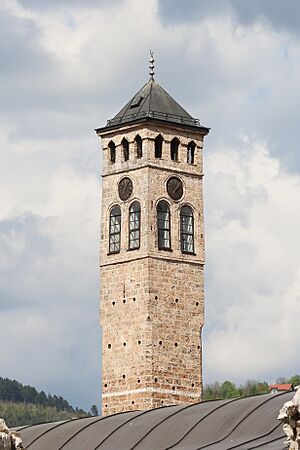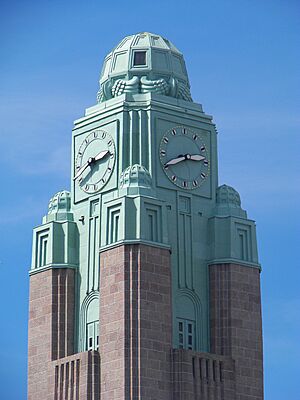Clock tower facts for kids
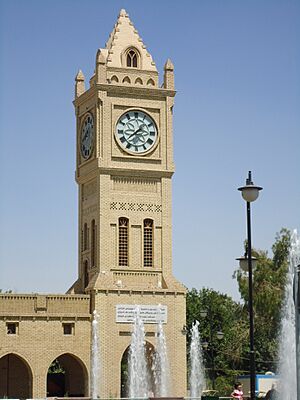
Clock towers are special buildings that hold a big clock and have one or more clock faces on their outside walls, usually near the top. Many clock towers stand by themselves, but some are attached to other buildings, like churches or town halls. While some other buildings might have clocks on them, they aren't called clock towers unless their main purpose is to be a tower for a clock.
Clock towers are seen all over the world, and some are very famous. A great example is the Elizabeth Tower in London, which most people call "Big Ben". But actually, Big Ben is just the name of the giant bell inside the tower!
Contents
What is a Clock Tower?
Many buildings have clocks, but not all of them are clock towers. A true clock tower is a building built especially to hold a clock. It usually has one or more (often four) clock faces. These towers can stand alone or be part of a church or a city building like a town hall.
The special clock machine inside the tower is called a turret clock. This clock often rings large bells or chimes to tell the time, sometimes even playing short tunes. Some clock towers were first built just for bells and then had clocks added later. Since they fit the idea of a tower, they are still considered clock towers.
Why Were Clock Towers Important?
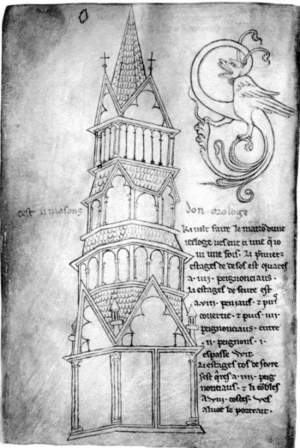
Today, we mostly admire clock towers for how they look. But a long time ago, they were super important! Before the mid-1900s, most people didn't have their own watches. Even home clocks were rare before the 1700s.
The very first clocks didn't even have faces. They were just "striking clocks" that rang bells to tell people when to work or pray. That's why they were put in tall towers – so the bells could be heard far away. Clock towers were often the tallest buildings in town centers. As they became more common, people realized that putting a dial on the outside would let everyone see the time whenever they wanted.
A Look Back in Time: History of Clock Towers
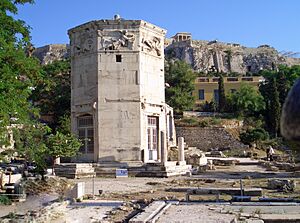
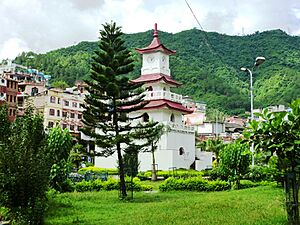
The idea of clock towers goes way back to ancient times. The oldest known "clock tower" was the Tower of the Winds in Athens, Greece. It was built around 50 BC. This tower had eight sundials on its outside. Inside, it had a water clock that used water from the Acropolis to tell time.
In China, during the Song dynasty, a clever inventor named Su Song built an amazing astronomical clock tower in 1088. It had a special water-powered system. In England, one of the first clocks was put in a tower in Westminster in 1288. Another was added to Canterbury Cathedral in 1292. The oldest working tower clock in Europe is the Salisbury Cathedral clock, finished in 1386.
A brilliant inventor named Al-Jazari from Mesopotamia (a region in the Middle East) built a very fancy clock in 1206. It was about 3.3 meters (11 feet) tall! This clock did more than just tell time. It showed the zodiac signs, the sun's and moon's paths, and even had a moving crescent moon that opened automatic doors every hour to show little figures. It could even be set to match the changing length of day and night throughout the year. Plus, it had five robot musicians who played music automatically!
Famous Clock Towers Around the World
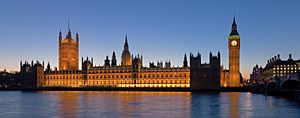
Many clock towers have become famous landmarks that people recognize instantly. Some well-known examples include:
- The Elizabeth Tower in London, England, built in 1859. It holds the famous "Big Ben" bell.
- The tower of Philadelphia City Hall in the United States.
- The Rajabai Tower in Mumbai, India.
- The Spasskaya Tower of the Moscow Kremlin in Russia.
- The Torre dell'Orologio in Venice, Italy.
- The Peace Tower of the Parliament of Canada in Ottawa.
- The Zytglogge clock tower in the Old City of Bern, Switzerland.
Tallest and Biggest Clock Towers
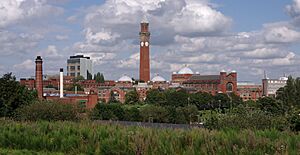
The tallest clock tower that stands by itself in the world is the Joseph Chamberlain Memorial Clock Tower (also called Old Joe). It's at the University of Birmingham in the United Kingdom. This tower is 100 meters (328 feet) tall and was finished in 1908. The clock tower of Philadelphia City Hall was part of the tallest building in the world from 1894 to 1908.
Some even taller buildings have had clocks added to them later. For example, the Palace of Culture and Science in Warsaw, Poland, had a clock added in 2000. It's about 187.68 meters (616 feet) tall to the roof. The NTT Docomo Yoyogi Building in Tokyo, Japan, got a clock in 2002. Its roof is 240 meters (787 feet) high.
The Abraj Al Bait complex in Mecca, Saudi Arabia, built in 2012, has the largest and highest clock faces on a building in the world. Its Makkah Royal Clock Tower is about 494.4 meters (1,622 feet) tall to where people can go, and 601 meters (1,972 feet) to its very tip. This tower has four clock faces, and two of them are huge – 43 meters (141 feet) across, located about 400 meters (1,312 feet) high!
Images for kids
See also
- List of clock towers
- Bell tower
- Minaret
- Street clock
- Thirteenth stroke of the clock


